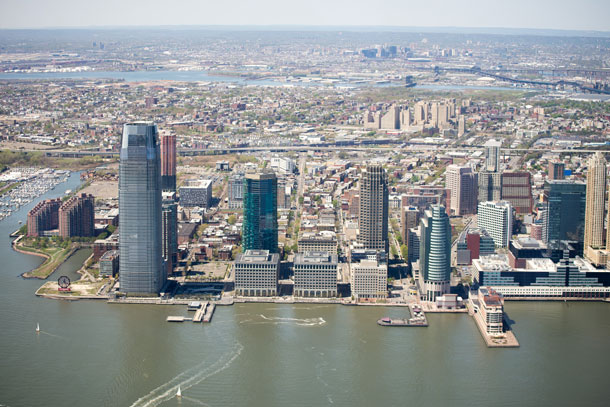Lead in Newark’s Water
Air Date: Week of January 11, 2019

Lead in drinking water is particularly dangerous for young children and fetuses. Even very low levels of lead in the early years of life can lead to learning disabilities, impaired blood cell formation, and damaged nervous systems. (Photo: Akihito Fujii, Flickr, CC BY 2.0)
Since the widely-publicized scandal of lead in the drinking water of Flint, Michigan, much has come to light about the high levels of lead in water supplies across the US. In Newark, New Jersey, hundreds of thousands of citizens may be at risk of exposure to lead in their water, and the city recently started handing out water filters to its citizens after plans to replace the lead piping system became stalled. Erik Olson, the Natural Resources Defense Council’s Senior Director of Health and Food joins Living on Earth’s Bobby Bascomb to talk about the lead water crisis.
Transcript
CURWOOD: Exposure to lead in the womb or during early childhood has been linked to disorders such as learning disabilities, delinquency and even crime later in life. In the lead crisis illuminated by problems in Flint, Michigan thousands of communities across the US are still served by water systems in violation of federal standards, and according to the Natural Resources Defense Council, that means more than 18 million people are at risk. The city of Newark, New Jersey is now in focus for its lead problems, and it was sued by NRDC to force a response. Erik Olson of NRDC recently spoke with Living on Earth’s Bobby Bascomb.
BASCOMB: So, what is going on in Newark in terms of lead in the drinking water? What's the situation there?
OLSON: Unfortunately, there are literally hundreds of systems sprinkled across the country in all 50 states that have lead contamination problems. Newark has a pretty serious lead contamination, which has been going on at least for a couple of years. We know at least since January of 2017, it had levels of lead that far exceed the EPA's action level, it's called. And a lot of kids especially are being put at risk from that.
BASCOMB: Well, I know there's no safe level of lead exposure. But what are the EPA standards for lead and what does Newark have?
OLSON: You're correct, there's no safe level of lead. The experts have been finding that even very low levels of lead can cause harm to a child's brain, especially as they're young and developing. So, we want to try to minimize the levels of lead. The American Academy of Pediatrics recommends no more than one part per billion of lead in any school drinking water, and we think that's a reasonable target. Unfortunately, Newark's levels are running at about 51 parts per billion, which is obviously way over anything anyone would consider safe. EPA's target for trying to treat the water is 15 parts per billion. So, Newark is running worse than three times the EPA action level right now, and far in excess of what experts like the American Academy of Pediatrics say is what we ought to be shooting for.
BASCOMB: And Newark is a pretty big city. It has a population of about 285,000, I've read, which is about three times more than Flint, Michigan, the city that has become synonymous with this problem of lead in the drinking water. How many people in Newark are actually drinking lead in their water potentially?
OLSON: Well, we don't know exactly how many people have excess lead in Newark, because they sampled maybe a hundred and 50 or so homes in recent months. And they're finding pretty high levels in many parts of the city. But, you know, 150 homes out of 280,000 is a small percentage that have been tested. So, we do know that there are thousands and thousands of these so called lead service lines. These are the pipes that go from the water main in the middle of the street to people's houses. So, we know that there are thousands of them across Newark. So, we’ve got a pretty serious and widespread problem in the city.
BASCOMB: So, these service lines there, the pipe themselves are made of lead?
OLSON: That's right. I mean, surprisingly, too many people all over the country really until as recently as the mid 1980s, pure lead pipes were often used to connect people's houses to the water main. The problem is, of course, that lead is poisonous. And when water runs through it, it's sort of like drinking your water through a lead straw, which is not what anybody wants to do. So, unfortunately, because of this old technology, we've got the estimates are as many as six million to 10 million homes served by these lead pipes. And because the city isn’t treating its water correctly, to make sure that the water is not corrosive. What's happening is the corrosive water is leaching lead out of the pipes, and even out of indoor plumbing and contaminating the tap water in many homes across the city.
BASCOMB: And remind us why is lead in the drinking water a problem what are the health concerns there and who is most at risk?
OLSON: Lead is a known very toxic chemical. It's especially dangerous to young kids and to pregnant moms and their fetuses. Because as the brain develops, lead interferes with normal brain development and can cause learning disabilities that can decrease the child's IQ, can cause behavioral problems, and there even is now evidence that it increases the likelihood of behavior issues, including criminal behavior later in life. And a lot of these impacts, unfortunately, it appears are irreversible. But adults also have adverse effects from lead in their drinking water and in their blood. We now know from recent studies that it can cause higher blood pressure and can be linked to cardiovascular disease in adults. So, there's an array of problems. I think kids and pregnant moms are the population we worry about most, but unfortunately, pretty much everybody has had some risk from lead in their drinking water.
BASCOMB: Well, if children are particularly susceptible, are there measures in place to keep them safe, say in schools at least?
OLSON: Well, in Newark, the schools have installed filters in order to try to reduce kids exposures to lead in their schools. And now Newark is - after Natural Resources Defense Council sued them on behalf of local citizens - they've started to offer filters to about 40,000 households across the city to filter out their water. It's not being offered to everyone in the city, which is a big problem. But we're hoping that we'll actually get filters in there for everybody until they actually fix the problem. Everybody at risk should be protected.

Newark has handed out 40,000 water filters to provide clean drinking water for the estimated affected population. (Photo: Massmatt, Flickr, CC BY 2.0)
BASCOMB: And are filters really adequate for filtering out lead?
OLSON: Well, if the filters are installed, right, and if they're maintained, those are two big if's, then they will remove lead. But there are problems for the vast majority of homes filters are really just a temporary stopgap measure to protect people while we're trying to fix the underlying problem. Basically, there are two things that a city like Newark needs to do to protect their citizens over the long term. First of all, they clearly need to treat their waters so it doesn't leach lead out of lead pipes. And secondly, we just need to pull all those lead pipes out of the ground. Even with a corrosion control treatment, it's not a full solution to the problem. Pipes are sort of a ticking time bomb. People can continue to be exposed to lead until they pulled out of the ground.
BASCOMB: Well, pulling out, this vast network of lead pipes digging up the streets putting in new pipes, I mean, that sounds really expensive. It's got to be a big hurdle for the city.
OLSON: It is a challenge. Many cities however, are doing this and have been doing it. So, you know, cities like Lansing, Michigan, Madison, Wisconsin, Milwaukee, other cities are starting to pull out or already have pulled out all their lead pipes. And you don't actually have to dig up the entire street and the entire front lawn, there is now, newer technologies where you can just dig a small pit at each end of the lead service line and pull a new pipe through while you pull out the old lead pipe. So, it's much cheaper and more efficient.
BASCOMB: Well, why are the EPA and the states dragging their feet on safe drinking water for people? I mean, why is this even an issue?
OLSON: There's a lot of political pressure against state government officials in some cases and against EPA, from anti-regulatory forces from city officials from water utility industry people that don't want to face enforcement action. So, they quietly have been pushing to cut EPA’s budget, to cut state budgets, and to put political pressure on the agencies to not bring enforcement action. And really it's created a culture that you can violate the law, you can violate the safe drinking water rules with impunity.
BASCOMB: Presumably, if there were enforcement actions, it would cost a municipality and the water providers a lot of money and they don't want that. And it's just become part of the culture to not enforce these laws, is that what you are saying?
OLSON: That's exactly right. I mean, we did a survey of enforcement actions and violations, we found that only three percent of the violations nationwide faced any threat of penalties. I think that sends a pretty clear signal you can imagine if you're on a highway, and everybody's speeding 40 miles an hour over the speed limit. And a cop is just sitting there watching everybody drive by and never pulling anybody over, what kind of signal that sends. And that's unfortunately, sort of where we are right now with our drinking water enforcement or lack of enforcement.

Erik Olson is the Senior Director of Health and Food with the Healthy People and Thriving Communities Program at the Natural Resources Defense Council. (Photo: Courtesy of the NRDC)
BASCOMB: Well, is there any bright side? Do you see any potential change in that or are cities or municipalities sort of taking it upon themselves to do the right thing in terms of providing safe drinking water?
OLSON: Yeah, I think that there are certainly responsible water utilities out there that are voluntarily starting to pull out their lead pipes. Lansing, Michigan, for example, pulled out all their lead pipes voluntarily. And there are other cities across the country that are starting to do this. So, I think there certainly are responsible members of the industry who want to do the right thing and view it as their responsibility. And honestly, I think as the new Congress is coming in, there are a lot of members who have recently been elected who said that they want to invest in our drinking water infrastructure. We know it's going to cost billions of dollars to fix these lead contamination problems and other drinking water contamination issues. And we're not starting to see Congress take an interest and I think there's a good chance that infrastructure legislation, especially if the public pushes hard, could address this issue and could help pay for pulling these lead pipes out of the ground. So stay tuned. I'm hopeful that maybe the new Congress coming in will make this a priority as well.
CURWOOD: That was Erik Olson of the NRDC speaking with Living on Earth’s Bobby Bascomb. The mayor of Newark, Ras Baraka, has told reporters quote, “At the end of the day, the city of Newark has done everything in its power to make sure we deal with and abate this issue in the city."
Links
Natural Resources Defense Council | “What’s in Your Water? An Updated Analysis”
Natural Resources Defense Council | “What's in Your Drinking Water?” | Guide
NJ.Com | “Newark Said Its Water Was Safe, but Email Reveals It Was Warned of Problems Months Ago”
Living on Earth wants to hear from you!
Living on Earth
62 Calef Highway, Suite 212
Lee, NH 03861
Telephone: 617-287-4121
E-mail: comments@loe.org
Newsletter [Click here]
Donate to Living on Earth!
Living on Earth is an independent media program and relies entirely on contributions from listeners and institutions supporting public service. Please donate now to preserve an independent environmental voice.
NewsletterLiving on Earth offers a weekly delivery of the show's rundown to your mailbox. Sign up for our newsletter today!
 Sailors For The Sea: Be the change you want to sea.
Sailors For The Sea: Be the change you want to sea.
 The Grantham Foundation for the Protection of the Environment: Committed to protecting and improving the health of the global environment.
The Grantham Foundation for the Protection of the Environment: Committed to protecting and improving the health of the global environment.
 Contribute to Living on Earth and receive, as our gift to you, an archival print of one of Mark Seth Lender's extraordinary wildlife photographs. Follow the link to see Mark's current collection of photographs.
Contribute to Living on Earth and receive, as our gift to you, an archival print of one of Mark Seth Lender's extraordinary wildlife photographs. Follow the link to see Mark's current collection of photographs.
 Buy a signed copy of Mark Seth Lender's book Smeagull the Seagull & support Living on Earth
Buy a signed copy of Mark Seth Lender's book Smeagull the Seagull & support Living on Earth

